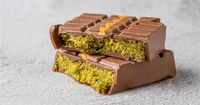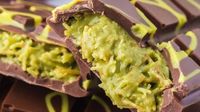In an exciting development for chocolate lovers, Lidl is set to launch its highly anticipated Dubai-style chocolate tablet at an incredibly low price of €4.99. This version is designed to capture the essence of the viral chocolate seen all over social media platforms.
Known for its thick structure and filled with a luscious pistachio cream paired with crispy kadaïf, the Dubai-style chocolate has taken the internet by storm, with thousands showcasing it in mouthwateringly appealing videos. What started as a luxury treat available for up to €40 has been made accessible to everyday consumers thanks to Lidl’s affordability strategy, with the new chocolate being available in stores starting March 27, 2025.
Many attributes its viral success to a range of social media influencers, particularly Maria Vehera, whose engaging TikTok video tasting the Dubai chocolate reached over 100 million views. The video showcased the moment of tasting—breaking into the rich chocolate, unveiling the pistachio cream hidden inside—sparking massive curiosity and enticing a wave of imitators eager to experience the treat for themselves.
The marketing success of this chocolate reflects consumers' escalating inclination toward exotic flavors and indulgent snacks, a trend that's been fueled significantly by digital engagement. Each bite is not just a dessert moment; it’s transformed into an experience meant to stimulate sight and sound, making it an ideal candidate for TikTok and Instagram shareability. This sensory engagement strategy has made the Dubai chocolate not just a product but a happening.
In an attempt to capitalize on this growing demand, famed chocolate brand Lindt released its interpretation of the Dubai-style chocolate, which also commands a higher price of nearly €10 per tablet. Lindt touts its version as premium—with 45% pistachios mixed into the filling—justifying its top-tier pricing as a hallmark of quality and innovation that serious chocolate aficionados can appreciate.
Consumers need discernment when opting for such novelty treats—they come with hefty calorie counts. For instance, the Dubai-style chocolate boasts about 800 calories per bar, along with 19 grams of saturated fats and 46 grams of sugar per 100 grams. While some may balk at the price and nutritional specifics, for many chocolate lovers, the unique taste and indulgent experience it provides more than justify the expense.
Lidl's chocolate emerges as an alternative designed for the budget-conscious yet still commands significant consumer interest. Users can expect a slightly less decadent chocolate, considering the price difference—while the Lidl chocolate might have less rich creaminess compared to its luxury counterparts, the delightful flavor of pistachio intertwined with a crispy texture remains a considerable draw.
As the launch date approaches, anticipation grows among consumers eager to try Lidl’s Dubai-style chocolate and also looking forward to the introduction of Dubai-style donuts set to be released on April 10, 2025. Shoppers are encouraged to get ready to fill their baskets as the trend flourishes beyond just one or two items.
As the Dubai-style chocolate phenomenon continues to expand, it illustrates the intricate relationship between social media influence and culinary trends today. Consumers are drawn not just to what they are eating but how it perceivably enhances their online presence, navigating a flavorful landscape that intricately intertwines digital culture with gastronomic enjoyment.
Embarking on this new chapter in the world of confectionery, Lidl and Lindt are both capitalizing on this current chocolate craze, rallying their respective followers. It raises questions about consumer choices in a visually-driven marketplace, nudging them towards a mindful approach to their indulgent pursuits.
The rise of Dubai-style chocolate is more than a sweet treat; it's a reflection of evolving consumer habits, a testament to how flavor innovations and marketing efforts continue to shape the way people engage with food.






